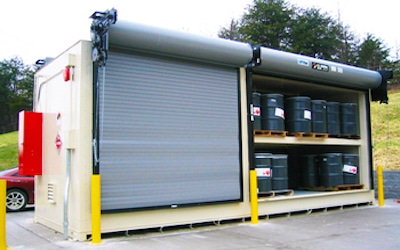Working with 55 Gallon Drums – Proper Storage & Handling Tips
As part of daily operations, many companies work with drums filled with chemicals, fuel and other liquids. Special care must be taken when moving and storing these drums. Using a 55-gallon drum storage building helps eliminate the risks associated with handling large quantities of hazardous materials. Read on for some helpful tips.
Prior to
storing drums inside a drum storage building, inspect each one for rust, dents or any sign of obstruction. Ensure the lids or bungs are in proper working order. Any sign of obstruction to the container could result in a leak or hazardous situation.
Before handling or transporting chemical drums, read the labels to understand the containers’ hazard classifications. If labels are missing or disintegrated, immediately report to officials. For your safety, never handle drums that have unknown contents.
Transporting Containers – 55-Gallon Drum Storage Building
Before moving containers, inspect the drums’ lid for any sign of stress or pressure. If a drum’s lid is bulging outwards, this may indicate that contents inside are having a chemical reaction.
Avoid moving chemicals into a 55 gallon drum storage building by hand. Moving drums by hand can cause the materials inside to shift, which can result in a spill or leak, or even cause physical injury. Use mechanical equipment including a forklift or drum dolly to safely transport drums. Never block exits or entry ways with drums.
In tight or cramped spaces, use a suspended
drum crane/hoist system to move drums throughout the building’s interior. The heavy-duty lifting system is completely customizable and extremely efficient for organizing drums.
All persons handling or storing chemical drums should wear personal protective equipment.
Containing a Chemical Spill
All U.S. Chemical Storage drum storage buildings include hand-welded, leak-tested
spill containment sumps. These are designed to catch any leaks or spills that may occur during storage, preventing them from getting into the soil under or around the building.
Per
EPA requirements, the sump capacity should be 10% of the volume of the containers stored in the building, or the volume of the largest container, whichever is greater. Factory Mutual (FM), a third-party certification agency, requires the sump size equal 25% of the total stored volume, or the volume of the largest container, whichever is greater.
In case of a spill, make sure all persons who handle, dispense, or store hazardous materials are trained in the hazards of the chemicals being used. It’s also vital to prepare an emergency response plan. Regularly review the plan with personnel to make sure everyone understands it.
55-Gallon Drum Storage Building Compliance and Safety
Are you prepared for storing chemical drums? Remain compliant with a 55 gallon
drum storage building. Contact us
online or call 800-233-1480 to learn more about compliant drum storage buildings.

